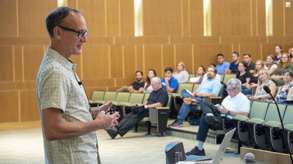Global NASH congress
ABSTRACT
Using the power of the world’s largest proteomic platform coupled with machine learning , clinical samples and known biopsy results were used to build proteomic models capable of staging steatosis, inflammation, ballooning and fibrosis, and diagnosing at-risk NASH. These models exhibit competitive performance vs. existing standard methods. Use-cases in drug development include a participant rule-out prior to biopsy and precision demonstration of pharmacodynamic mechanistic impacts on individual liver components with multiple longitudinal measurements. Combination of the liquid liver biopsy with other proteomic tests on the same platform can expand the assessment of drug impact to include changes in cardiovascular risk, insulin resistance, kidney function and body composition. This will result in smaller, faster and more comprehensive clinical trials in the future.
Highlights:
- Proteomic models capable of staging and diagnosing conditions for “at-risk” NASH
- Assessment of pharmacodynamic mechanisms over time
- Simultaneous drug impact assessment of multiple biological metrics

Stephen A. Williams, MD, PhD
Chief Medical Officer, SomaLogic
Steve Williams, MD, Ph.D, practiced medicine for over a decade at Charing Cross Hospital before joining Pfizer, where he became the VP and Worldwide Head of Clinical Technology. Since 2009 he has been the Chief Medical Officer at SomaLogic, where his focus has been on developing clinical tests using proteomic signatures.
2021 Global NASH Congress | The “liquid liver biopsy”: Development of serum proteomic tests for liver biopsy components and diagnosos of at-rish NASH
A presentation by Stephen A. Williams, MD, PhD
More webinars
WebinarProteomics in Clinical Trials: Lessons from Semaglutide Treatment in Individuals with Obesity
Advancements in proteomic profiling have opened new avenues for understanding the complex mechanisms underlying obesity and its comorbidities. By measuring thousands of proteins at once, researchers gain a comprehensive view of an individual’s metabolic health, revealing subclinical processes and pinpointing potential therapeutic targets.
WebinarPathways to Digital Health: AI and Omics in Rheumatoid Arthritis
Explore how groundbreaking proteomic research is transforming our understanding of rheumatoid arthritis (RA). In this on-demand webinar, Allan Stensballe, PhD, shares new insights into the molecular landscape of RA-affected synovial tissue, revealing how autoantibodies and protein signatures may hold the key to more precise personalized therapies.
WebinarUsing Antibody Profiling to Identify Novel Diagnostic Biomarkers
Current cancer screening methods often lead to false positives, false negatives and invasive biopsies that lack prognostic insights. Emerging research suggests that cancer-specific IgM and IgG antibodies – produced by B cells upon recognizing malignant cells – could serve as stable, easily measurable blood biomarkers for detecting and monitoring high-incidence cancers like melanoma and breast, prostate, bowel, lung and pancreatic cancer. This approach has the potential to improve early diagnosis, reduce uncertainty and enhance treatment planning.





